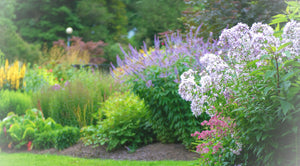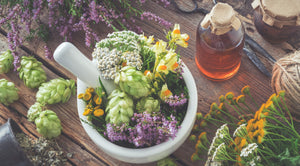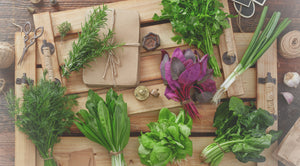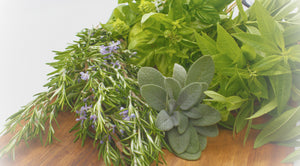Lavender brings to mind both a color and an aroma. The genus name, Lavendula, comes from the Latin word, lavare, meaning "to wash". Lavender has been used as a perfuming agent since ancient times. It experienced a brief hiatus during the Dark Ages when bathing was considered a sinfully sensuous experience! But, during the later Middle Ages it was revived as a useful agent in repelling insects and banishing the dampness - it was regularly strewn across the damp floors of houses and churches and was even hoped to keep away the plague.
Lavender plants are an evergreen perennial, in the mint family, and originally native to the rocky hillsides of the Mediterranean. Exposure to the blazing sun and the lack of rainfall makes this a tough little herb. It has fine hairs on its leaves which work to protect it from the cold and reduce transpiration in the summer. The foliage has a tendency to conserve and hold moisture, therefore it is important not to over water. Lavenders do not like WET FEET!
The lovely grey-green foliage of lavender plants makes this a wonderful addition to any perennial border, and there are many good varieties that form an evergreen edging around an herb garden. Grow specimen varieties in pots, or add to your potted gardens on the patio. One of our most popular lavender plants is Lavender Provence!
Since the coldest winters are too harsh for these tender perennials, bring them inside to brighten up even the coldest, darkest winter days. It is important to keep this herb well-pruned in the winter.
Harvesting lavender plants is easy. In early morning right after the dew is dry on the flowers is a good time to harvest. The lavender spikes should be cut when most all of the flowers have opened. Cut where the stem meets the leaves. Tie in bunches using a rubber band hang upside down in a dry dark place with good air circulation. In 2-3 weeks you will have preserved your lavender to use as you like.
Lavender plants make wonderful herb garden gifts.
Lavender plants are an evergreen perennial, in the mint family, and originally native to the rocky hillsides of the Mediterranean. Exposure to the blazing sun and the lack of rainfall makes this a tough little herb. It has fine hairs on its leaves which work to protect it from the cold and reduce transpiration in the summer. The foliage has a tendency to conserve and hold moisture, therefore it is important not to over water. Lavenders do not like WET FEET!
The lovely grey-green foliage of lavender plants makes this a wonderful addition to any perennial border, and there are many good varieties that form an evergreen edging around an herb garden. Grow specimen varieties in pots, or add to your potted gardens on the patio. One of our most popular lavender plants is Lavender Provence!
Since the coldest winters are too harsh for these tender perennials, bring them inside to brighten up even the coldest, darkest winter days. It is important to keep this herb well-pruned in the winter.
Harvesting lavender plants is easy. In early morning right after the dew is dry on the flowers is a good time to harvest. The lavender spikes should be cut when most all of the flowers have opened. Cut where the stem meets the leaves. Tie in bunches using a rubber band hang upside down in a dry dark place with good air circulation. In 2-3 weeks you will have preserved your lavender to use as you like.
Lavender plants make wonderful herb garden gifts.





